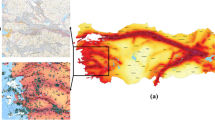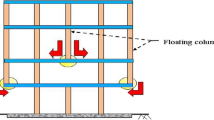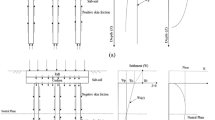Abstract
Seismic behavior analyses of cantilever retaining walls are affected by saturated backfills. There are records of retaining walls that include fines content in the backfill with up to 95 kPa cohesiveness. The behavior of such backfills is different than clean cohesionless backfills and affects the retaining wall seismic response and liquefaction potential. Due to lack of such well-instrumented sites for analyses of these types of walls during seismic event, this study aims at analyses of such walls using validated numerical analyses. A 3 m- and 9 m-high cantilever retaining wall with saturated backfill was simulated to investigate the seismic response of the wall under 0.25–0.65 g peak ground acceleration (PGA). The probability of liquefaction and its effects were assessed. To validate the numerical procedure, a cantilever retaining wall modeled in a centrifuge test by others was simulated numerically in a previous research by authors and referred briefly herein. The validated numerical model was used to investigate the effect of dirty backfills with 10 kPa and 30 kPa cohesions on lateral displacement, foundation settlement, total seismic active pressure and its point of action, porewater pressure ratio, backfill deformation pattern, potential failure surfaces (PFS), and wall failure mode.


























Similar content being viewed by others
Data availability
The datasets generated during and/or analyzed during the current study are available from the corresponding author on reasonable request.
References
Agusti GC, Sitar N (2013) Seismic earth pressures on retaining structures in cohesive soils. California Department of Transportation
Argyroudis S, Kaynia AM, Pitilakis K (2013) Development of fragility functions for geotechnical constructions: application to cantilever retaining walls. Soil Dyn Earthq Eng 50:106–116
Arulmoli K, Muraleetharan KK, Hossain MM, Fruth LS (1992) VELACS: verification of liquefaction analysis by centrifuge studies. Lab Test Progr Soil Data Rep 90:562
Arulanandan K, Scott RF (1993) Project VELACS—control test results. J Geotech Eng 119(8):1276–1292
Anderson DG, Martin GR, Lam I, Wang JN (2008) Seismic analysis and design of retaining walls, buried structures, slopes, and embankments. (Vol. 611). Transportation Research Board (NCHRP)
Bakr J, Ahmad SM, Lombardi D (2019) Finite-element study for seismic structural and global stability of cantilever-type retaining walls. Int J Geomech 19(10):04019117
Banerjee R, Chattaraj R, Parulekar YM, Sengupta A (2021) Numerical prediction of undrained cyclic triaxial experiments on saturated Kasai river sand using two constitutive models of liquefaction. Bull Eng Geol Env 80:8565–8582
Biggs JM (1964) Introduction to structural dynamics. McGraw-Hill, New York
Bowles JE (1996) Foundation analysis and design. By McGraw-Hill Book Companies, New York
Budhu M (2015) Soil mechanics fundamentals. John Wiley & Sons, New York
Byrne PM (1991) A cyclic shear-volume coupling and pore-pressure model for sand. In Proceedings: Second International Conference on Recent Advances in Geotechnical Earthquake Engineering and Soil Dynamics (St. Louis, Missouri, March 1991), Paper No. 1.24: 47–55
Dewoolkar MM, Ko HY, Pak RYS (2000) Experimental developments for studying static and seismic behavior of retaining walls with liquefiable backfills. Soil Dyn Earthq Eng 19(8):583–593. https://doi.org/10.1016/S0267-7261(00)00069-5
Dewoolkar MM, Ko HY, Pak RY (2001) Seismic behavior of cantilever retaining walls with liquefiable backfills. J Geotech Geoenviron Eng 127(5):424–435. https://doi.org/10.1061/(ASCE)1090-0241(2001)127:5(424)
Dewoolkar MM, Chan AHC, Ko HY, Pak RY (2009) Finite element simulations of seismic effects on retaining walls with liquefiable backfills. Int J Numer Anal Meth Geomech 33(6):791–816
Ganesh R, Rajesh S (2021) Analytical solution to estimate the point of application of resultant passive earth thrust against unsaturated retaining structures. Geomech Geoeng 16(6):509–516
Gao H, Hu Y, Wang Z, Wang C, Chen G (2017) Shaking table tests on the seismic performance of a flexible wall retaining EPS composite soil. Bull Earthq Eng 15(12):5481–5510
Gibbs HJ, Holtz WG (1957) Research on determining the density of sand by spoon penetration testing. In: Proceedings, 4th international conference on soil mechanics and foundation engineering, London, I: 35–39
Goudarzy M, Sarkar D, Wichtmann T (2022) Influence of plastic fines content on the liquefaction susceptibility of sands: cyclic loading. Acta Geotech 17(11):4977–4988
Green RA, Olgun CG, Cameron WI (2008) Response and modeling of cantilever retaining walls subjected to seismic motions. Comput-Aid Civil Infrastruct Eng 23(4):309–322
Huang Y, Yashima A, Sawada K, Zhang F (2008) Numerical assessment of the seismic response of an earth embankment on liquefiable soils. Bull Eng Geol Env 67:31–39
Iai S, Kameoka T (1993) Finite element analysis of earthquake induced damage to anchored sheet pile quay walls. Soils Found 33(1):71–91
Iraji A, Osouli A (2020) Liquefaction numerical analysis of a cantilevered retaining wall using a simple finn-byrne model. Geo-Congress 2020: geotechnical earthquake engineering and special topics. American Society of Civil Engineers, Reston, pp 41–50
Itasca (2011) FLAC 7.0. Itasca Consulting Group Inc, Minneapolis, MN
Jo SB, Ha JG, Yoo M, Choo YW, Kim DS (2014) Seismic behavior of an inverted T-shape flexible retaining wall via dynamic centrifuge tests. Bull Earthq Eng 12(2):961–980
Kapuskar M (2005) Field investigation report for abutment backfill characterization. Earth Mechanics Inc, prepared for California Department of Transportation (Caltrans) and University of California San Diego, Sacramento, CA
Karafagka S, Fotopoulou S, Karatzetzou A, Kroupi G, & Pitilakis K (2022) Seismic performance and vulnerability of gravity quay wall in sites susceptible to liquefaction. Acta Geotech 1–22
Madabhushi SPG, Zeng X (1998) Seismic response of gravity quay walls. II: numerical modeling. J Geotech Geoenviron Eng 124(5):418–427
Manzanal D, Bertelli S, Lopez-Querol S, Rossetto T, Mira P (2021) Influence of fines content on liquefaction from a critical state framework: the Christchurch earthquake case study. Bull Eng Geol Env 80:4871–4889
Mikola RG, Candia G, Sitar N (2014) Seismic earth pressures on retaining structures and basement walls. In: Tenth U.S. National Conference on Earthquake Engineering, Frontiers of Earthquake Engineering, Anchorage, Alaska
Newmark NM, Hall WJ (1982) Earthquake spectra and design. Earthquake Engineering Research Institute, Berkeley
Osouli A, Zamiran S (2017) The effect of backfill cohesion on seismic response of cantilever retaining walls using fully dynamic analysis. Comput Geotech 89:143–152
Peck RB, Hanson WE, Thornburn TH (1974) Foundation engineering, 2nd edn. John Wiley & Sons, New York
PEER Strong Motion Database
Psarropoulos PN, Tsompanakis Y & Katsirakis M (2022) Dynamic soil-structure interaction between retaining walls. retaining soil and retained structures. Bull Earthqu Eng, 1–25
Rajesh BG, Choudhury D (2017) Generalized seismic active thrust on a retaining wall with submerged backfill using a modified pseudodynamic method. Int J Geomech 17(3):06016023
Shamsabadi A, Rollins KM, Kapuskar M (2007) Nonlinear soil–abutment–bridge structure interaction for seismic performance-based design. J Geotech Geoenviron Eng 133(6):707–720
Taiyab MA, Alam MJ, Abedin MZ (2014) Dynamic soil-structure interaction of a gravity quay wall and the effect of densification in liquefiable sites. Int J Geomech 14(1):20–33
Wilson P, Elgamal A (2015) Shake table lateral earth pressure testing with dense c-/ backfill. Soil Dyn Earthq Eng 71:13–26
Ye J, Wang G (2016) Numerical simulation of the seismic liquefaction mechanism in an offshore loosely deposited seabed. Bull Eng Geol Env 75:1183–1197
Zamiran S, Osouli A (2018) Seismic motion response and fragility analyses of cantilever retaining walls with cohesive backfill. Soils Found 58(2):412–426
Zeng X, Steedman RS (1993) On the behavior of quay walls in earthquakes. Geotechnique 43(3):417–431
Zeng X (1998) Seismic response of gravity quay walls. I: centrifuge modeling. J Geotech Geoenviron Eng 124(5):406–417
Zeng X (2005) Effect of liquefaction on stability of retaining walls. In Geo-Frontiers Congress: Earthquake Engineering and Soil Dynamics, Austin, Texas, United States
Zhuang H, Chen G, Hu Z, Qi C (2016) Influence of soil liquefaction on the seismic response of a subway station in model tests. Bull Eng Geol Env 75:1169–1182
Funding
The authors declare that no funds, grants, or other support were received during the preparation of this manuscript.
Author information
Authors and Affiliations
Contributions
AI: Methodology, Validation, Formal analysis, Resources, Writing—Original Draft, Investigation, Resources, Data Curation, Project administration. AO: Supervision, Writing–Review & Editing, Conceptualization.
Corresponding author
Ethics declarations
Conflict of interest
The authors have no relevant financial or non-financial interests to disclose.
Additional information
Publisher's Note
Springer Nature remains neutral with regard to jurisdictional claims in published maps and institutional affiliations.
Rights and permissions
Springer Nature or its licensor (e.g. a society or other partner) holds exclusive rights to this article under a publishing agreement with the author(s) or other rightsholder(s); author self-archiving of the accepted manuscript version of this article is solely governed by the terms of such publishing agreement and applicable law.
About this article
Cite this article
Iraji, A., Osouli, A. Liquefaction numerical analysis of cantilevered retaining walls with saturated backfill containing fines content. Acta Geotech. (2024). https://doi.org/10.1007/s11440-023-02181-z
Received:
Accepted:
Published:
DOI: https://doi.org/10.1007/s11440-023-02181-z




